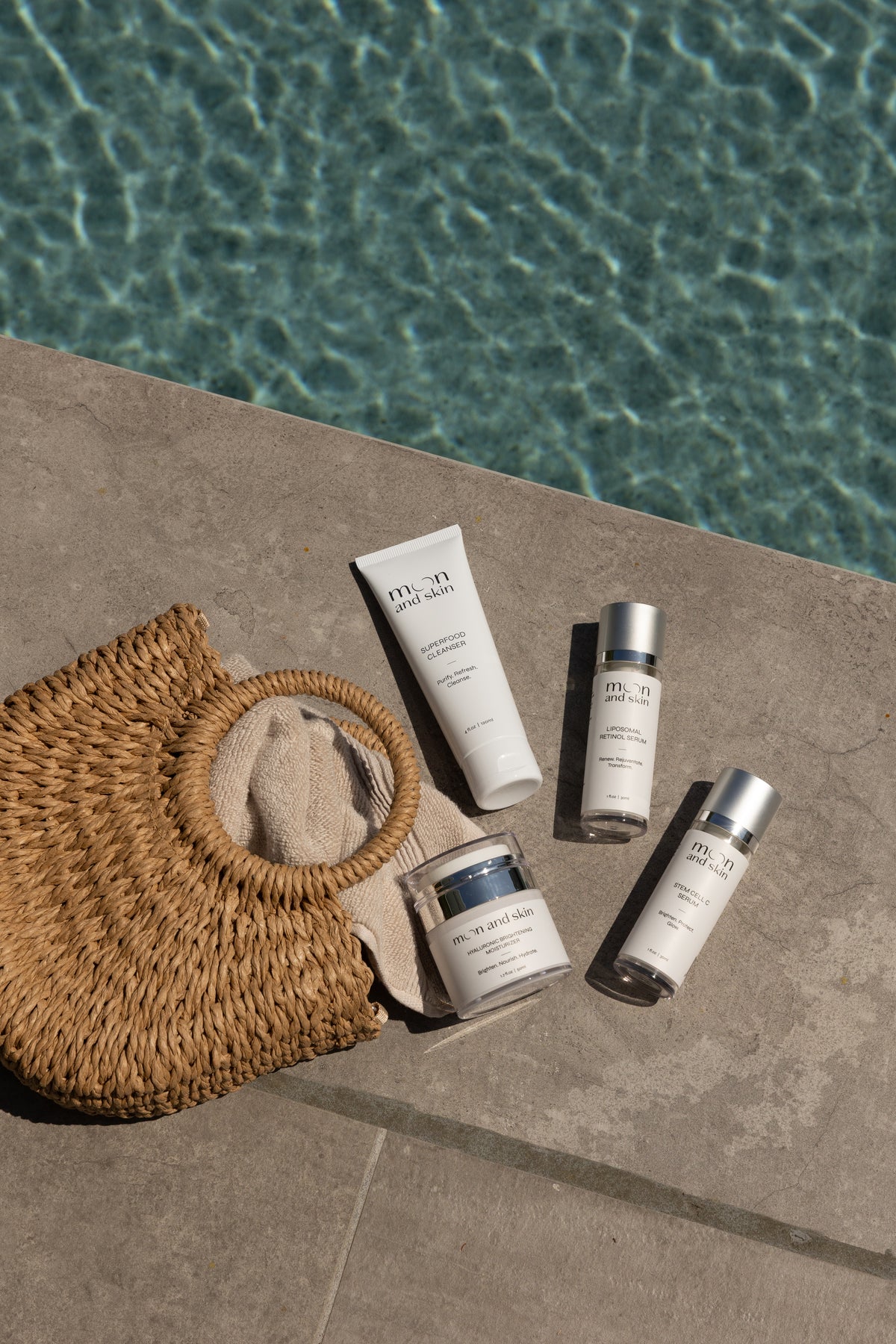Table of Contents
Introduction
Have you ever wondered about the hidden complexities of your skincare ingredients? With the multitude of options available, understanding how each component interacts with our skin can feel overwhelming. One frequently discussed ingredient is ferulic acid, a powerful antioxidant that has garnered attention in the skincare community for its protective properties against environmental damage. However, a question that often arises is: does ferulic acid cause sun sensitivity?
As we navigate through the intricacies of skincare, we understand that our community seeks clarity on how to effectively incorporate ingredients into their routines without compromising skin health. This blog post aims to provide you with a thorough understanding of ferulic acid, its benefits, and whether it contributes to sun sensitivity. We'll explore how it works, its synergy with other ingredients, and share insights on how to use it safely alongside sun protection.
Together, we’ll explore how ferulic acid can enhance your skincare regimen while remaining vigilant against sun exposure. By the end of this post, you’ll be equipped with knowledge to make informed choices about your skincare routine, ensuring your skin remains vibrant and healthy without compromising safety.
What is Ferulic Acid?
Ferulic acid is a plant-based antioxidant found in the cell walls of various fruits, grains, and vegetables, such as oats, brown rice, and apples. It plays a crucial role in protecting plants from oxidative stress caused by environmental factors, particularly UV radiation. By neutralizing free radicals, ferulic acid helps prevent cellular damage, making it a valuable ally in skincare formulations.
The Science Behind Ferulic Acid
At its core, ferulic acid acts as a scavenger for free radicals—unstable molecules that can cause significant damage to skin cells if left unchecked. Studies have shown that it can reduce oxidative stress by up to 40%, thereby protecting skin from cumulative damage caused by daily environmental exposure.
One notable study published in the International Journal of Nutrition, Pharmacology, Neurological Diseases highlighted ferulic acid's role in restoring the viability of skin cells after UV exposure. When applied topically, ferulic acid was found to restore skin cell viability from a mere 28% after UV exposure to an impressive 98%. This remarkable ability to mitigate UV damage underscores the importance of incorporating ferulic acid into our skincare routines.
Benefits of Ferulic Acid in Skincare
Incorporating ferulic acid into your skincare regimen can yield numerous benefits, including:
- Antioxidant Protection: Protects the skin from free radical damage caused by UV rays and environmental pollutants.
- Enhanced Efficacy of Other Ingredients: Works synergistically with other antioxidants, particularly vitamin C and vitamin E, stabilizing them and enhancing their effectiveness.
- Reduction of Signs of Aging: Helps minimize fine lines, wrinkles, and sagging by preserving collagen and elastin integrity.
- Brightening Effects: Assists in evening out skin tone and reducing hyperpigmentation, leaving the skin looking radiant.
With such a robust profile of benefits, it’s easy to see why ferulic acid is a staple in many skincare products, including our Stem Cell C Serum, which combines the power of ferulic acid with stable vitamin C for enhanced brightening and protective effects.
Does Ferulic Acid Cause Sun Sensitivity?
The short answer is no; ferulic acid does not inherently cause sun sensitivity. Unlike some ingredients, such as retinol or certain chemical exfoliants, ferulic acid is generally well-tolerated and safe for use in sunny conditions. In fact, it may even provide some level of protection against UV damage.
Understanding Skin Sensitivity
To clarify, sun sensitivity refers to a condition where the skin becomes more reactive to sunlight, often resulting in irritation, redness, or burning. This is commonly triggered by certain skincare ingredients that increase the skin's reactivity to UV rays. Ingredients known to cause increased sun sensitivity include:
- Retinoids: While effective for anti-aging, they can make the skin more prone to sunburn.
- Alpha Hydroxy Acids (AHAs): These exfoliants can thin the skin's outer layer, increasing vulnerability to UV exposure.
- Beta Hydroxy Acids (BHAs): Similar to AHAs, BHAs can enhance sun sensitivity due to their exfoliating properties.
In contrast, ferulic acid works differently. Instead of making the skin more sensitive, it actively protects against oxidative stress, particularly from UV rays. Therefore, using ferulic acid in conjunction with a broad-spectrum sunscreen can enhance your skin's defense against sun damage.
The Importance of Sunscreen
Regardless of the ingredients in your skincare routine, daily sun protection remains crucial. Even with the protective benefits of ferulic acid, it should never replace sunscreen. At Moon and Skin, we emphasize the importance of a comprehensive skincare regimen that includes a high-SPF sunscreen. This is essential for safeguarding your skin from both UVA and UVB rays, which can lead to premature aging and increase the risk of skin cancer.
Recommendations for Use
When incorporating ferulic acid into your routine, consider the following tips:
- Layer Wisely: If using a product with ferulic acid, apply it before your moisturizer and sunscreen. This ensures optimal absorption and utilizes its antioxidant benefits effectively.
- Combine with Other Antioxidants: For enhanced protection, pair ferulic acid with vitamin C and vitamin E. This potent trio works synergistically to combat free radicals and improve overall skin health.
- Be Cautious with Exfoliants: While ferulic acid is safe, if you are using other actives like retinol or strong exfoliants, monitor your skin closely. It's essential to avoid overloading your skin with too many active ingredients that could lead to irritation.
- Patch Test: As with any new product, perform a patch test to ensure your skin does not react negatively to ferulic acid or any other components in the formulation.
The Synergistic Power of Ferulic Acid with Other Ingredients
Ferulic acid is especially notable for its ability to enhance the stability and efficacy of other antioxidants, particularly vitamin C and vitamin E. This combination not only boosts the antioxidant capabilities of each ingredient but also provides a more comprehensive approach to skin protection and rejuvenation.
Ferulic Acid and Vitamin C
Vitamin C is renowned for its brightening and protective properties but is notoriously unstable. Ferulic acid stabilizes vitamin C, doubling its potency and extending its shelf life. This synergy allows for not just improved brightness but also enhanced protection against photoaging.
When combined in a product like our Stem Cell C Serum, the result is a powerful formulation that not only brightens but also protects against environmental stressors, making it a must-have in your daily routine.
Ferulic Acid and Vitamin E
Vitamin E is another antioxidant that works hand-in-hand with ferulic acid. Together, they provide a multi-layered defense against oxidative stress. Vitamin E also contributes to skin hydration, further enhancing the overall benefits of your skincare routine.
How to Incorporate Ferulic Acid into Your Skincare Routine
Step-by-Step Application
- Cleanse: Begin with our gentle Superfood Cleanser to remove impurities and prepare your skin for active ingredients.
- Tone (Optional): If you use a toner, apply it after cleansing to balance the skin’s pH.
- Apply Ferulic Acid: Use a serum containing ferulic acid. We recommend looking for products that combine it with vitamin C and E for maximum benefits.
- Moisturize: Follow with a hydrating moisturizer, such as our Hyaluronic Brightening Moisturizer, which will enhance hydration and support your skin barrier.
- Sunscreen: Finish your routine with a broad-spectrum sunscreen, especially if you plan to be outdoors.
Evening Routine
In the evening, you can still include ferulic acid in your regimen but consider incorporating it with other actives such as retinol. Remember to adjust the frequency based on your skin's tolerance.
Common Misconceptions about Ferulic Acid
Myth 1: Ferulic Acid Increases Sun Sensitivity
As discussed, ferulic acid does not cause sun sensitivity. Instead, it serves as a protective barrier against UV-induced damage. Always pair it with sunscreen for optimal protection.
Myth 2: Ferulic Acid is Only for Aging Skin
While ferulic acid is particularly beneficial for mature skin, its antioxidant properties make it suitable for all ages. Early incorporation can help prevent damage and maintain youthful skin.
Myth 3: Ferulic Acid Can Replace Sunscreen
Ferulic acid is a powerful antioxidant but should not be seen as a substitute for sunscreen. Always use a broad-spectrum SPF as part of your daily routine.
Conclusion
Navigating the world of skincare can be complex, especially when it comes to understanding how various ingredients interact with one another and with sun exposure. Ferulic acid stands out as a protective and stabilizing ingredient that enhances your skin's resilience against environmental stressors without causing sun sensitivity.
We encourage you to embrace ferulic acid as a part of your skincare journey, knowing that when paired with proper sun protection, it can significantly benefit your skin's health and appearance.
Consider trying our Bundle & Save collection, which features our core products, including the Stem Cell C Serum and Hyaluronic Brightening Moisturizer, to create a comprehensive routine tailored to your skin's needs.
FAQ
1. Can I use ferulic acid with retinol?
Yes, you can use ferulic acid with retinol. However, it's advisable to monitor your skin's response, as both ingredients can be potent.
2. How often should I use ferulic acid?
Ferulic acid can be used daily. Start with every other day and adjust based on your skin's tolerance.
3. Is ferulic acid safe for sensitive skin?
Generally, ferulic acid is well-tolerated by most skin types. However, if you have extremely sensitive skin, it's prudent to perform a patch test first.
4. Does ferulic acid expire?
Yes, like most skincare ingredients, ferulic acid can degrade over time. It's best to store products in a cool, dark place and use them within the recommended time frame.
5. Can I use ferulic acid in my morning routine?
Absolutely! Ferulic acid is ideal for the morning routine as it provides antioxidant protection against daily environmental aggressors. Just remember to follow up with sunscreen.
By understanding the role of ferulic acid and how to effectively integrate it into our skincare regimen, we can empower ourselves to make informed choices that celebrate and nurture our skin through every phase of life.







